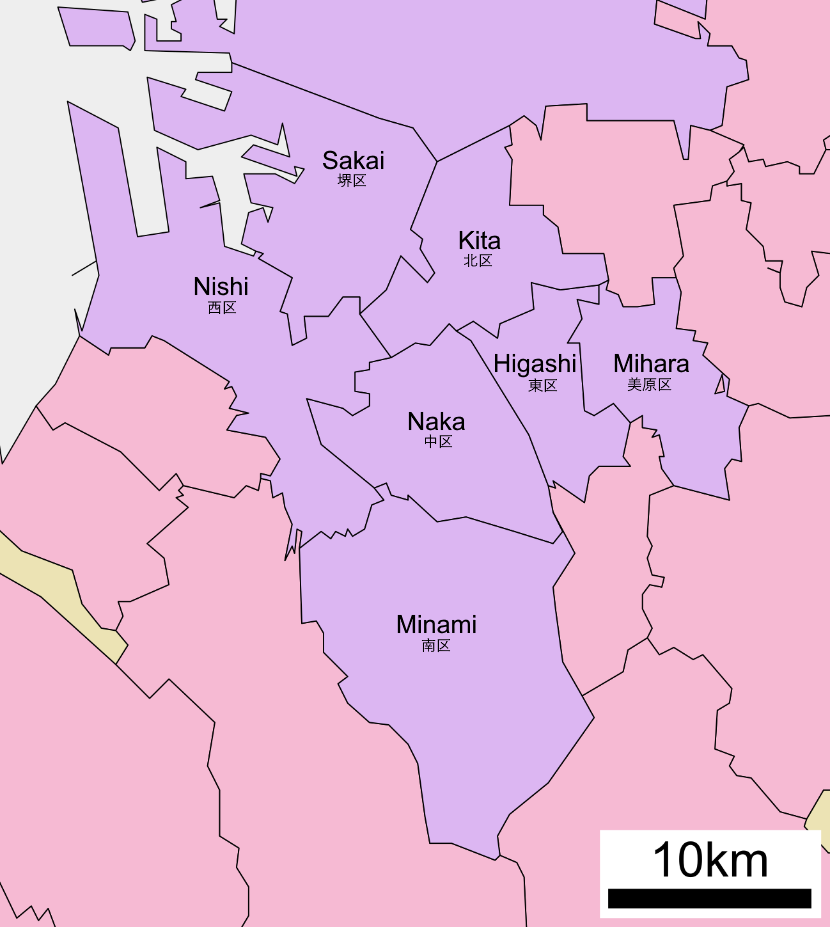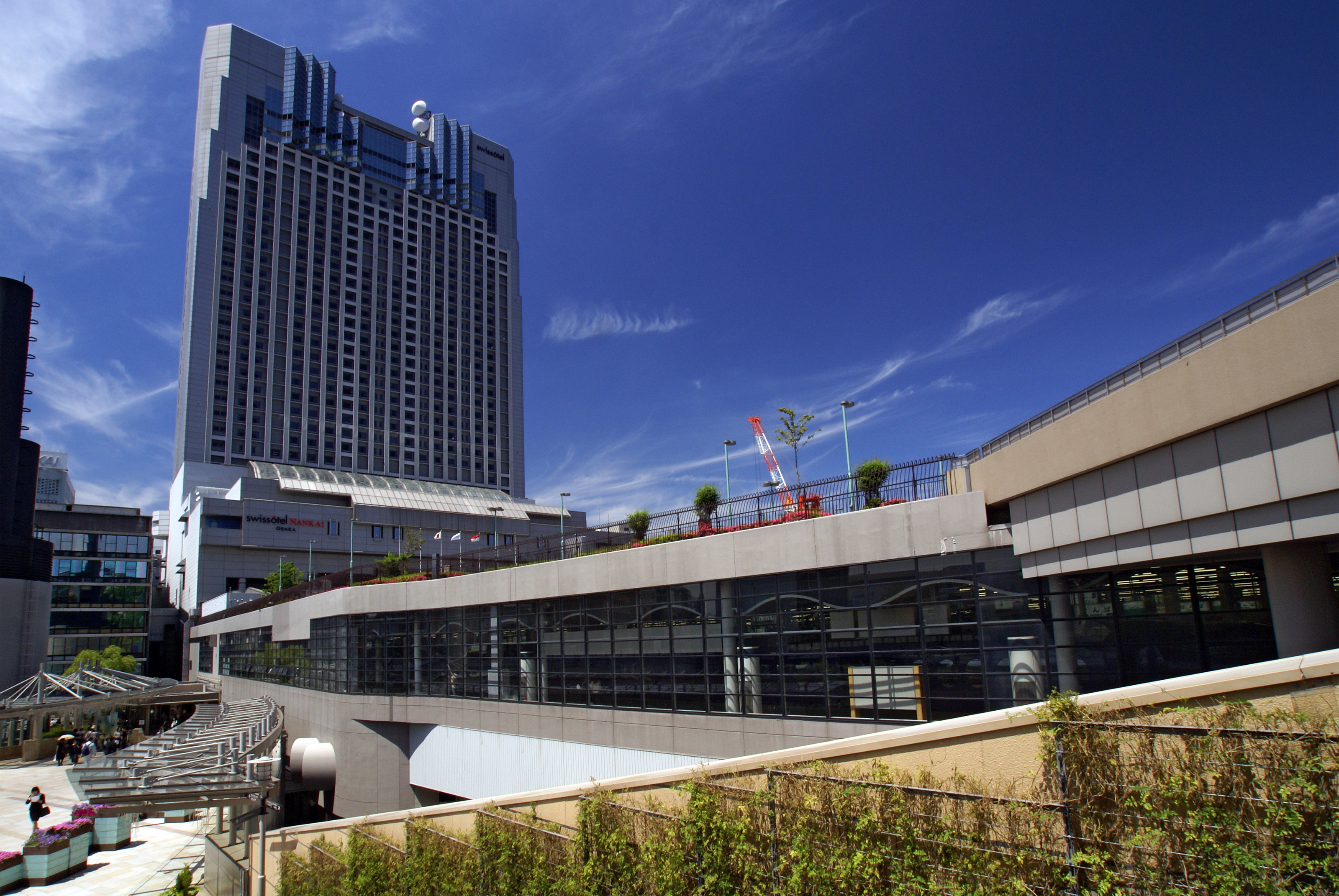|
Kōmyōike Station
is a passenger railway station located in Minami-ku, Sakai, Osaka Prefecture, Japan, operated by Nankai Electric Railway. It is station number NK91. It is named for Kōmyōike Pond, an artificial lake that dates from 1936 and is itself named for Empress Kōmyō. A small monument at the lake commemorates the work of the Korean laborers who constructed it. Lines Kōmyōike Station is served by the Nankai Semboku Line, and is located 12.1 kilometers from the opposing terminus of the line at and 25.5 kilometers from . Station layout The station consists of one elevated island platform An island platform (also center platform (American English) or centre platform (British English)) is a station layout arrangement where a single platform is positioned between two tracks within a railway station, tram stop or transitway inte ... with the station building underneath. Platforms History Kōmyōike Station opened on 20 August 1977. On 1 April 2025, this station came under ... [...More Info...] [...Related Items...] OR: [Wikipedia] [Google] [Baidu] |
Railway Station
Rail transport (also known as train transport) is a means of transport using wheeled vehicles running in railway track, tracks, which usually consist of two parallel steel railway track, rails. Rail transport is one of the two primary means of land transport, next to road transport. It is used for about 8% of passenger and rail freight transport, freight transport globally, thanks to its Energy efficiency in transport, energy efficiency and potentially high-speed rail, high speed.Rolling stock on rails generally encounters lower friction, frictional resistance than rubber-tyred road vehicles, allowing rail cars to be coupled into longer trains. Power is usually provided by Diesel locomotive, diesel or Electric locomotive, electric locomotives. While railway transport is capital intensity, capital-intensive and less flexible than road transport, it can carry heavy loads of passengers and cargo with greater energy efficiency and safety. Precursors of railways driven by human or an ... [...More Info...] [...Related Items...] OR: [Wikipedia] [Google] [Baidu] |
Minami-ku, Sakai
is a ward of the city of Sakai in Osaka Prefecture, Japan. The ward has an area of 40.44 km2 and a population of 155,266. The population density is 3,839 per km2. (Ward office official home page) (Retrieved on June 23, 2009) The name means "South Ward." The wards of Sakai were established when Sakai became a city designated by government ordinance on April 1, 2006. Education Universities and colleges * Tezukayama Gakuin University Izumigaoka Campus *[...More Info...] [...Related Items...] OR: [Wikipedia] [Google] [Baidu] |
Sakai, Osaka
is a city located in Osaka Prefecture, Japan. It has been one of the largest and most important seaports of Japan since the medieval era. Sakai is known for its ''kofun'', keyhole-shaped burial mounds dating from the fifth century. The ''kofun'' in Sakai include the largest grave in the world by area, Mozu Tombs, Daisen Kofun. Once known for Katana, swords, Sakai is now famous for the quality of its Japanese kitchen knife, cutlery. , the city had an estimated population of 819,965, making it the fourteenth most populous city in Japan (excluding Tokyo). Geography Sakai is located in southern Osaka Prefecture, on the edge of Osaka Bay and directly south of the city of Osaka. Neighboring municipalities Osaka Prefecture *Habikino, Osaka, Habikino *Izumi, Osaka, Izumi *Kawachinagano, Osaka, Kawachinagano *Matsubara, Osaka, Matsubara *Osaka *Ōsakasayama, Osaka, Ōsakasayama *Takaishi, Osaka, Takaishi Climate Sakai has a Humid subtropical climate (Köppen ''Cfa'') characterized by w ... [...More Info...] [...Related Items...] OR: [Wikipedia] [Google] [Baidu] |
Osaka Prefecture
is a prefecture of Japan located in the Kansai region of Honshu. Osaka Prefecture has a population of 8,778,035 () and has a geographic area of . Osaka Prefecture borders Hyōgo Prefecture to the northwest, Kyoto Prefecture to the north, Nara Prefecture to the southeast, and Wakayama Prefecture to the south. Osaka is the capital and largest city of Osaka Prefecture, and the third-largest city in Japan, with other major cities including Sakai, Higashiōsaka, and Hirakata. Osaka Prefecture is located on the western coast of the Kii Peninsula, forming the western is open to Osaka Bay. Osaka Prefecture is the third-most-populous prefecture, but by geographic area the second-smallest; at it is the second-most densely populated, below only Tokyo. Osaka Prefecture is one of Japan's two " urban prefectures" using the designation ''fu'' (府) rather than the standard '' ken'' for prefectures, along with Kyoto Prefecture. Osaka Prefecture forms the center of the Keihanshin metro ... [...More Info...] [...Related Items...] OR: [Wikipedia] [Google] [Baidu] |
Japan
Japan is an island country in East Asia. Located in the Pacific Ocean off the northeast coast of the Asia, Asian mainland, it is bordered on the west by the Sea of Japan and extends from the Sea of Okhotsk in the north to the East China Sea in the south. The Japanese archipelago consists of four major islands—Hokkaido, Honshu, Shikoku, and Kyushu—and List of islands of Japan, thousands of smaller islands, covering . Japan has a population of over 123 million as of 2025, making it the List of countries and dependencies by population, eleventh-most populous country. The capital of Japan and List of cities in Japan, its largest city is Tokyo; the Greater Tokyo Area is the List of largest cities, largest metropolitan area in the world, with more than 37 million inhabitants as of 2024. Japan is divided into 47 Prefectures of Japan, administrative prefectures and List of regions of Japan, eight traditional regions. About three-quarters of Geography of Japan, the countr ... [...More Info...] [...Related Items...] OR: [Wikipedia] [Google] [Baidu] |
Nankai Electric Railway
is a private railway in Japan, founded in 1884. The name ''Nankai'' (which means "South Sea") comes from the company's routes along the Nankaidō, the old highway that ran south from the old capital, Kyoto, along the sea coast. Nankai predates all the electric railways in the Tokyo region. The Nankai network branches out in a generally southern direction from Namba Station in Osaka. The Nankai Main Line connects Osaka to Wakayama, with an important spur branching to Kansai International Airport. The '' rapi:t α'' express connects Kansai International Airport to Namba in 34 minutes, while the '' rapi:t β'' takes 39 minutes with two additional stops. The Koya Line connects Osaka to Mt. Koya, headquarters of the Buddhist Shingon sect and a popular pilgrimage site. IC cards ( PiTaPa and ICOCA) are accepted. History The Nankai Railway Company was founded on June 16, 1884. In 1944 it was one of the companies that merged to form Kinki Nippon Railway Co., Ltd. (Kin-nichi, ... [...More Info...] [...Related Items...] OR: [Wikipedia] [Google] [Baidu] |
Empress Kōmyō
(701 – 23 July 760), born Fujiwara Asukabehime (藤原 安宿媛), was the consort of Japanese Emperor Shōmu (701–756) during the Nara Period.Ponsonby-Fane, Richard. (1959). ''The Imperial House of Japan,'' pp. 57-58. Life A member of the Fujiwara clan, her father was Fujiwara no Fuhito and her mother was Agata Inukai no Michiyo (県犬養三千代). During her life she was also known as Asukabehime (安宿媛), Kōmyōshi (光明子), and Tōsanjō (藤三娘), literally the third Fujiwara daughter. In 716, Kōmyō married the future Emperor Shōmu when he was still the crown prince. Two years later, she gave birth to her daughter, Princess Abe, who would later rule as Empress Kōken and Empress Shōtoku. Her son was born in 727 and was soon named crown prince, but he died as an infant. Rumors circulated that Prince Nagaya cursed the infant prince using black magic, and Nagaya was forced to commit suicide in response. Kōmyō was named queens-consort or "kōgō" i ... [...More Info...] [...Related Items...] OR: [Wikipedia] [Google] [Baidu] |
Semboku Line
The is a railway line in Osaka Prefecture, Japan, operated by the private railway operator Nankai Electric Railway. The line connects Izumi-Chūō Station and Nakamozu Station, with through operations to and from the Kōya Line up to Namba Station in southern downtown Osaka. Services Along with services inside the line, through trains also operate to the Kōya Line beyond Nakamozu to . ; (LE) :All seats are reserved. Operations started on 5 December 2015. Trains pass Sakaihigashi and Fukai non-stop for the first time. ; (SbE) :Operated all day, through to Namba. ; (SmE) :Trains are operated all day, through to Namba. ; (L) :Operated all day. Mainly shuttles between Nakamozu and Izumi-Chūō (some trains for Komyoike). During the daytime and late at night, some services operate between Izumi-Chūō and Namba. List of stations All stations are located in Osaka Prefecture. *O: Trains stop. *, : Trains pass. *See the Koya Line article for the stops of the through trains ... [...More Info...] [...Related Items...] OR: [Wikipedia] [Google] [Baidu] |
Terminal Station
A train station, railroad station, or railway station is a railway facility where trains stop to load or unload passengers, freight, or both. It generally consists of at least one platform, one track, and a station building providing such ancillary services as ticket sales, waiting rooms, and baggage/freight service. Stations on a single-track line often have a passing loop to accommodate trains travelling in the opposite direction. Locations at which passengers only occasionally board or leave a train, sometimes consisting of a short platform and a waiting area but sometimes indicated by no more than a sign, are variously referred to as "stops", "flag stops", " halts", or "provisional stopping places". The stations themselves may be at ground level, underground, or elevated. Connections may be available to intersecting rail lines or other transport modes such as buses, trams, or other rapid transit systems. Terminology ''Train station'' is the terminology typicall ... [...More Info...] [...Related Items...] OR: [Wikipedia] [Google] [Baidu] |
Island Platform
An island platform (also center platform (American English) or centre platform (British English)) is a station layout arrangement where a single platform is positioned between two tracks within a railway station, tram stop or transitway interchange. Island platforms are sometimes used between the opposite-direction tracks on twin-track route stations as they are cheaper and occupy less area than other arrangements. They are also useful within larger stations, where local and express services for the same direction of travel can be accessed from opposite sides of the same platform instead of side platforms on either side of the tracks, simplifying and speeding transfers between the two tracks. The historical use of island platforms depends greatly upon the location. In the United Kingdom the use of island platforms on twin-track routes is relatively common when the railway line is in a cutting or raised on an embankment, as this makes it easier to provide access to the platf ... [...More Info...] [...Related Items...] OR: [Wikipedia] [Google] [Baidu] |
Koya Line
The is a railway line in Osaka Prefecture and Wakayama Prefecture, Japan, owned and operated by the Nankai Electric Railway, a private railway operator. It connects Osaka and Koyasan, the capital of the Japanese Buddhist sect Shingon, via the suburbs of Osaka, such as Sakai, Osaka, Sakai, Osakasayama, Osaka, Osakasayama, Tondabayashi, Osaka, Tondabayashi and Kawachinagano, Osaka, Kawachinagano in Osaka Prefecture and Hashimoto, Wakayama, Hashimoto and Kōya, Wakayama, Kōya in Wakayama Prefecture. To distinguish it from other Nankai Lines, the Kōya Line is indicated with pictograms of coniferous-like trees which bring to mind Mount Kōya, or with the line colour, green. For historical reasons, the line formally begins at Shiomibashi Station in Osaka and crosses the Nankai Main Line, the company's other main line, at Kishinosato-Tamade Station, though operationally it starts at Namba Station together with the Nankai Line, diverges at Kishinosato-Tamade Station and goes to Gokura ... [...More Info...] [...Related Items...] OR: [Wikipedia] [Google] [Baidu] |




